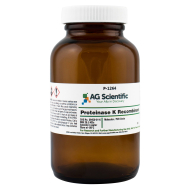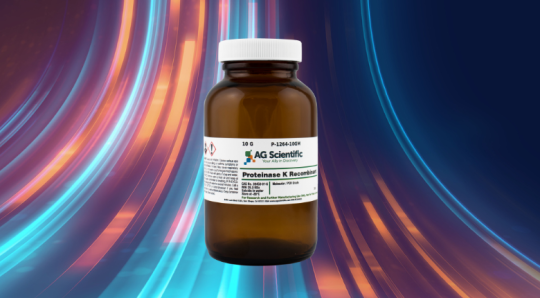In molecular biology Proteinase K (also protease K or endopeptidase K) is a broad-spectrum serine protease. The enzyme was discovered in 1974 in extracts of the fungus Engyodontium album (formerly Tritirachium album). Proteinase K is able to digest native keratin (hair), hence, the name "Proteinase K".
Why is this enzyme used in DNA extraction?
Proteinase K is used during DNA extraction to digest many contaminating proteins present. It also degrades nucleases that may be present in DNA extraction and protects the nucleic acids from nuclease attack.What are the applications of Proteinase K?
Applications for Next Generation Sequencing (NGS) and Microarray Technologies:
- Nucleic acid purification by inactivating nucleases when extracting DNA and RNA from yeast, bacteria, and mammalian cell & plant cell lysates
- Improves cloning efficiency of PCR products
- Sample preparation for quantification of DNA adduct levels by accelerator mass spectrometry
- Inactivation of enzyme cocktails in ribonuclease protection assays
- Added to extraction procedures to optimize RNA yields from primary breast tumors for microarray studies
Applications for Molecular Biology:
- Detection of Bovine Spongiform Encephalopathy proteins which are uniquely resistant to proteolytic degradation.
- Tissue digestion (denatures proteins) as an alternative sample preparation approach for quantitative analysis using liquid chromatography—tandem mass spectrometry.
- Specifically modify cell surface proteins to analyze membrane structures for protein localization
- Generates protein fragments used in characterization of functional studies
What are the guidelines for using PK?
- Isolation of high molecular weight DNA: Chromosomal DNA that has been embedded in agarose plugs can be treated with proteinase K to inactivate rare-cutting restriction enzymes used to digest the DNA. The enzyme is used for this method at a concentration of 1 mg/ml in a buffer containing 0.5M EDTA and 1% N-lauroylsarcosine (v/v). Incubate 24-48 hours at 37°C.
- Isolation of plasmid and genomic DNA: Genomic or plasmid DNA can be isolated from liquid nitrogen frozen cells or cultured cells using proteinase K. Incubate 50-100 mg of tissue or 1x108 cells in 1 ml of buffer containing 0.5% SDS (w/v) with proteinase K at a concentration of 1 mg/ml, for 12-18 hours at 50°C.
- Isolation of RNA: For cytoplasmic RNA isolation, centrifuge the cell lysate, remove the supernate and add 200 ug/ml proteinase K and SDS to 2% (w/v). Incubate for 30 minutes at 37°C. Total RNA can be isolated by passing the lysate through a needle fitted to a syringe prior treatment with the enzyme.
- Inactivation of RNases, DNases and enzymes in reactions: Proteinase K is active in a wide variety of buffers. The enzyme should be used at a ratio of approximately 1:50 (w/w, proteinase K: enzyme). Incubation is at 37°C for 30 minutes.
Why is digestion performed at 50°C?
Increasing the temperature to 50°C will unfold some proteins making it easier for Proteinase K to degrade them. The enzyme is stable and activity is greatly increased with the addition of denaturing agents such as SDS and urea. What is the quickest most effective way to inactivate proteinase K?
The most effective way to inactivate the enzyme, as with most proteins is to increase the temperature or change the pH significantly. Proteinase K is inactivated by heat (e.g. incubating at 55°C).
Proteinase K Activity in Buffers:
| Buffer (pH 8.0, 50°C, 1.25 µg/ml protease K, 15 min incubation) | Proteinase K activity (%) |
| 30 mM Tris·Cl | 100% |
| 30 mM Tris·Cl; 30 mM EDTA; 5% Tween 20; 0.5% Triton X-100; 800 mM GuHCl | 313% |
| 36 mM Tris·Cl; 36 mM EDTA; 5% Tween 20; 0.36% Triton X-100; 735 mM GuHCl | 301% |
| 10 mM Tris·Cl; 25 mM EDTA; 100 mM NaCl; 0.5% SDS | 128% |
| 10 mM Tris·Cl; 100 mM EDTA; 20 mM NaCl; 1% Sarkosyl | 74% |
| 10 mM Tris·Cl; 50 mM KCl; 1.5 mM MgCl2; 0.45% Tween 20; 0.5% Triton X-100 | 106% |
| 10 mM Tris·Cl; 100 mM EDTA; 0.5% SDS | 120% |
| 30 mM Tris·Cl; 10 mM EDTA; 1% SDS | 203% |
How do you determine if the enzyme is working?
To determine if the enzyme is working, you can do the following 2 steps- Find how many micromoles of the p-nitroanilide are produced per minute.
- Then divide by the total amount of protein in the solution, you can determine the specific activity of the enzyme = units (one unit equals 1 mole of p-nitroanilide produced/min), specific activity = units of enzyme activity/mg total protein.
Where does Proteinase K cleave?
Proteinase K cleaves peptide bonds next to the carboxyl group of N-substituted hydrophobic, aliphatic, and aromatic amino acids. It also cleaves peptide amides.How long does this product last?
It has a shelf life of 12 months when stored in a dry place at 2–8°C, due to the fact that it is a very stable. Short term storage at ambient temperatures do not harm the enzyme’s activity and stability.Additional Reading
- 8 Benefits of Choosing AGS as Your Proteinase K Supplier
- Proteinase K - Bulk Packaging & Labeling Services
- 6 Reasons to Initiate Change Control with Manufacturers


